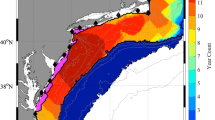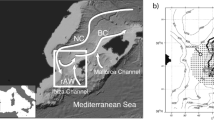Abstract
Observations of sea surface currents by HF radar were carried out in the Bungo Channel in summer 1992. The current ellipses of M2 constituent obtained by the observational results agree quite well with those obtained by the ADCP observations, showing that the accuracy of the HF radar measurements is of the same level as ADCP. The results revealed the current structures and their change with the Kyucho in detail. The Kyucho is influenced by the complicated coastal geometry and does not propagate straightly into the Bungo Channel. It propagates further inward after charging the coastal bays with warm water. The current directions change largely, since the currents turn around the stagnant region in the bay filled with the warm water. The northward intrusion begins to be weakened in the southern part of the channel, while it still persists in the northern part. The northward current speeds of the observed Kyucho are about 50 cm/s and sometimes attain 60 to 70 cm/s.
Similar content being viewed by others
References
Akiyama, H. and S. Saitoh (1993): TheKyucho in Sukumo Bay induced by Kuroshio warm filament intrusion.J. Oceanogr.,49, 667–682.
Iguchi, T., T. Umehara, Y. Ohno and K. Kozaki (1989): Observation of ocean currents and sea state with an HF ocean radar.Rev. Com. Res. Lab.,35, 387–397 (in Japanese).
Koizumi, Y. (1991): The process of water exchange in Shitaba Bay during the phenomenon ofKyucho.Bull. Coast. Oceanogr.,29, 82–89 (in Japanese).
Matthews, J. P., A. D. Fox and D. Prandle (1993): Radar observation of an along-front jet and transverse flow convergence associated with a North Sea front.Cont. Shelf Res.,13, 109–130.
Ohno, Y. (1991): HF ocean radar observations of ocean current.J. Com. Res. Lab.,38, 377–385.
Ohno, Y. (1993): Present stage of the HF ocean radar at Communications Research Laboratory and results of experiments.Navigation,116, 62–68 (in Japanese).
Prandle, D. (1987): The fine-structure of nearshore tidal and residual circulations revealed by H.F. radar surface current measurements.J. Phys. Oceanogr.,17, 231–245.
Shkedy, Y., D. Fernandez, C. Teague, J. Vesecky and J. Roughgarden (1995): Detecting upwelling along the central coast of California during an El Ninõ year using HF-radar.Cont. Shelf Res.,15, 803–814.
Stewart, R. H. and J. W. Joy (1974): HF radio measurements of surface currents.Deep-Sea Res.,21, 1039–1049.
Takeoka, H. and T. Kikuchi (1991): A method of estimating tidal currents using ADCP data.Bull. Coast. Oceanogr.,29, 76–81 (in Japanese).
Takeoka, H. and T. Yoshimura (1988): The Kyucho in Uwajima Bay.J. Oceanogr. Soc. Jpn.,44, 6–16.
Takeoka, H., H. Akiyama and T. Kikuchi (1993): The Kyucho in the Bungo Channel, Japan—Periodic intrusion of oceanic warm water.J. Oceanogr.,49, 369–382.
Author information
Authors and Affiliations
Rights and permissions
About this article
Cite this article
Takeoka, H., Tanaka, Y., Ohno, Y. et al. Observation of the Kyucho in the Bungo Channel by HF radar. J Oceanogr 51, 699–711 (1995). https://doi.org/10.1007/BF02235460
Received:
Revised:
Accepted:
Issue Date:
DOI: https://doi.org/10.1007/BF02235460




